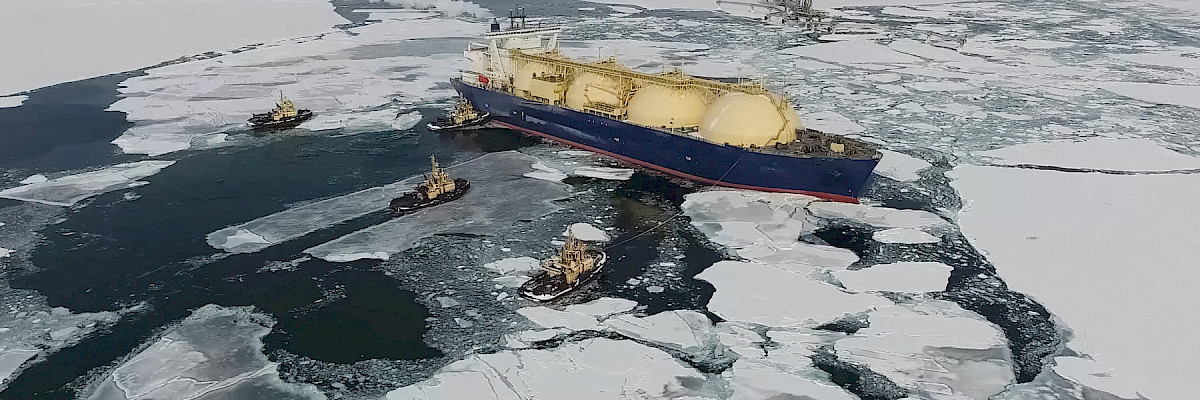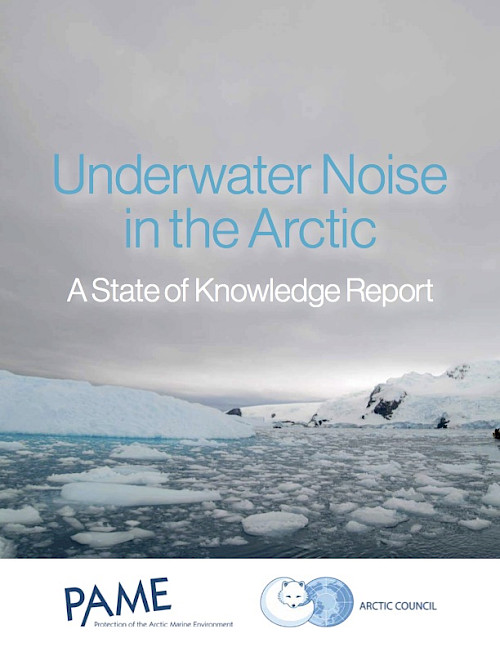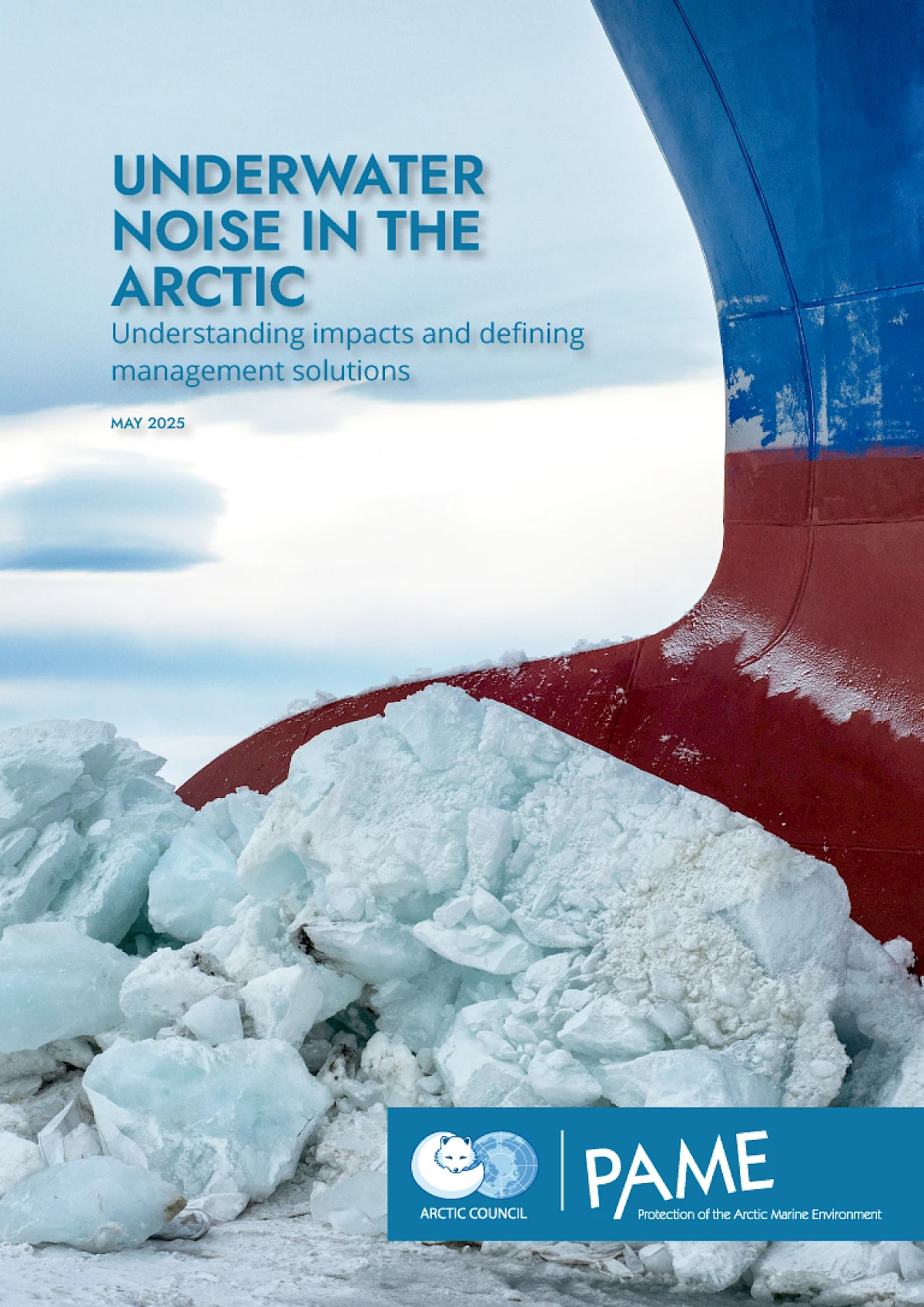
Underwater Noise in the Arctic
Shipping is one of multiple underwater noise-producing activities in the Arctic, and along with mineral extraction and exploration (through seismic survey), as well as port construction, introduces noise into the water, changes the underwater soundscape, and has the potential to negatively affect marine ecosystems and Indigenous and local ways of life.
In January 2025, PAME approved the Underwater Noise in the Arctic - Understanding impacts and defining management solutions Report - Phase II.
Underwater noise from shipping is recognised as a serious environmental problem that has impacts on Arctic species, ecosystems and ecosystem services.
The goal of this report is to improve understanding of underwater noise and identify possible actions that may help address this issue in the Arctic by assessing contributions of underwater noise from shipping under various economic and environmental scenarios.
This report explores current and future Arctic shipping and associated underwater noise at two timepoints: 2019 to represent the present and 2030, to present the near future based on a modelled shipping scenario reflecting growth in shipping sectors.
The report focuses across the whole Arctic Ocean, as well as three sub-regions where there is a high overlap of ship traffic with habitats of noise-sensitive species (whales and other marine mammals). It also evaluates noise implications of several ship traffic management measures and presents the results of these in each sub-region.
This was PAME's third report on the topic.
The following summarises the main findings of this report:
1. The Arctic is a special case when it comes to underwater sound. The addition of a relatively small number of vessels can have a large impact in historically less trafficked Arctic waters.
2. Regional knowledge gaps for characteristics that affect how sound travels underwater, together with physical, chemical and biological changes to the ocean resulting from climate change, make it challenging to assess underwater noise in the Arctic.
3. Models such as those used in this project enable testing of scenarios, including vessel management measures, that have the potential to affect underwater noise, in order to support decision- and policy-making.
4. This modelling predicts that with no further policy action, by 2030, underwater noise from shipping will increase across the Arctic Ocean, including into the Central Arctic Ocean, as a result of more ship traffic and reductions in sea ice extent and thickness.
5. Increases in noise levels will not be uniform. In sub-regions with less shipping (Chukchi Sea), changes will be large despite only modest increases in shipping. In sub-regions with heavy shipping (Barents Sea), overall changes will not be as marked but ship noise will be persistently higher than ambient levels across most of the sea.
6. Measures with the potential to influence underwater noise (speed reduction, rerouting and technological changes at the source (the ship)) were tested using real-world and hypothetical scenarios that reflected vessel management decision-making in Baffin Bay, the Barents Sea and the Chukchi Sea.
7. The implications of these measures were evaluated relative to both current and future traffic. The success of different measures at reducing underwater noise both now and in the future was context-specific, but generally not high, for several reasons, and underscored the importance of incorporating noise reduction goals directly into vessel management planning if URN reduction goals are to be achieved.
8. A trade-off of re-routing vessels is a shift in underwater noise from one location to another. Because of this, direct goals for reducing underwater noise should be spatially defined and multiple spatial scales used to explore consequences of such measures on underwater sound propagation, as well as other consequences, such as to navigational safety.
9. This is also true for regional, sub-regional and target biological area evaluations of benefits achieved through fleet or sector-specific technical changes in vessel design to reduce noise emissions: such changes may be considered ineffective at the scale of the region but highly beneficial locally or vice versa, depending on the scale of the goal and the composition of traffic affecting that goal.
10. Spatial measures to manage underwater noise should consider the inclusion of buffer areas and be sufficiently dynamic to keep pace with rapid changes in the geographic distribution and movement patterns of Arctic species.
11. The use of vessel speed limits to decrease noise from growing traffic in Arctic habitats of concern may not be effective if traffic is predominantly travelling slowly to begin with and/or if the decreases in speed do not correlate to significant decreases in vessel source level for the ship types affected.
12. Next steps for this work could include applying lessons learned to build regional Arctic monitoring and management practices that form a common basis for decision-making to preserve the health of Arctic marine species and ecosystems.
STORYMAP ABOUT THE 2025 report
Phase II: Underwater Noise pollution from Shipping in the Arctic (2021)
Following publication of the State of Knowledge report, in 2019, PAME embarked on new work to map, for the first time, underwater noise from shipping across the whole Arctic Ocean.
This was as complex task – there are many gaps in our knowledge about how sound travels in the Arctic’s cold, ice covered waters, and few locations in the Arctic where the underwater soundscape has been measured for long time periods.
Using information from PAME’s Arctic Ship Traffic Database (ASTD) and the expertise of bioacousticians, underwater noise from ships operating in the Arctic was modelled and mapped from 2013 to 2019.
During winter months when much of the Arctic Ocean is covered with sea ice, underwater noise from shipping was concentrated in areas with more open water: the Barents and Kara Seas, the southern Bering Sea, and along the Greenland coast of Baffin Bay.
In summer months, noise levels were higher and spread out farther, into the Canadian Archipelago, the Chukchi and Beaufort Seas and even the Central Arctic Ocean.
Underwater noise from shipping increased substantially from 2013 to 2019. During that six-year period, some parts of the Arctic experienced a doubling in the amount of underwater noise. These findings are consistent with those from PAME’s Arctic Shipping Status updates, that show the number of ships operating and the distance they travelled in Arctic waters, as defined by the Polar Code, grew over the same six-year period.
Like most of the world’s oceans, this work shows that shipping is altering the ambient underwater soundscape of the Arctic Ocean. As sea ice continues to diminish, shipping and underwater noise will grow.
Underwater noise in some parts of the Arctic is already at levels that are likely interfering with the abilities of whales, seals, and walrus to communicate and use sound, and could be affecting other marine life. Given the importance of Arctic marine mammals and healthy marine ecosystems to Arctic coastal Indigenous peoples, this issue warrants further attention.
"The Arctic region is a unique environment when it comes to underwater noise and the potential impacts that increasing noise levels could have on animals in the Arctic. There are a number of factors which contribute to its uniqueness compared to non-Arctic waters, including the sources of ambient sound, and how ice cover can affect sound propagation properties."
 Phase I: Underwater State of Knowledge Report
Phase I: Underwater State of Knowledge Report
The Arctic region is a unique environment when it comes to underwater noise and the potential impacts that increasing noise levels could have on animals in the Arctic. There are a number of factors which contribute to its uniqueness compared to non-Arctic waters, including the sources of ambient sound, and how ice cover can affect sound propagation properties.
The Arctic is also home to a number of endemic marine species, many for which the making, hearing, and processing of sounds serve critical biological functions, including communication, foraging, navigation, and predator-avoidance. Most importantly, the culture and livelihoods of Indigenous Peoples in the Arctic depend on the continued health of marine mammals, to a greater degree than in other regions of the world.
The issue of underwater noise and its effect on marine biodiversity has received increasing attention, with recognition by international and regional agencies, commissions and organisations. These include the Convention of Migratory Species (CMS), the Convention on Biological Diversity (CBD), the International Whaling Commission (IWC), the International Union for Conservation of Nature (IUCN), the International Maritime organization (IMO), the United Nations General Assembly (UNGA) and United Nations Convention on the Law of the Sea (UNCLOS), the European Parliament and European Union, the OSPAR Convention for the Protection of the Marine Environment of the North-East Atlantic and the Convention on the Protection of the Marine Environment of the Baltic Sea Area (HELCOM).
Internationally, work is currently underway in numerous fora to better understand the impacts and identify ways to mitigate the effects of underwater noise, including at the IMO, IWC, and at the United Nations more generally. In the 2009 Arctic Marine Shipping Assessment (AMSA) PAME first identified the issue of underwater noise as one which required further focus in the Arctic context, finding that “sound is of vital biological importance to most, if not all, marine vertebrates and anthropogenic noise produced through shipping can have various adverse effects on Arctic species.” PAME subsequently recommended that Arctic States engage with relevant international organisations to further assess the effects of ship noise on marine mammals, and to consider developing and implementing mitigation strategies.
Due to the recent activities on this topic, PAME decided to complete this State of Knowledge Review on Underwater Noise in the Arctic in order to get a baseline understanding of underwater noise in Arctic regions, including ambient sound levels, underwater noise created by anthropogenic activities, and impacts of underwater noise on marine life, including marine mammals, fish, and invertebrates.
This report is intended to be used as an overview of the current scientific knowledge on underwater noise in the Arctic. However, in the undertaking of this work, it has become clear that there are many gaps in this knowledge which, if addressed, could lead to a more comprehensive understanding of the effects of underwater noise on species of interest. That being said, this review will serve as a useful basis for which to consider where to focus future work and resources in both studying the issue of underwater noise in the Arctic context and in considering possible approaches in terms for mitigation strategies in reducing the effects or impacts of underwater noise on the Arctic marine environment and marine species.
Underwater Noise in the Arctic - A state of Knowledge Report
SUMMARY
The two current largest sources of anthropogenic noise in the Arctic are vessel traffic and seismic airguns, although active drilling platforms, marine construction, and navy sonar also create noise. Source levels for vessel traffic in the Arctic have only been measured a few times, and mostly for ice breaking activity. Ice breaking noise is typically higher than normal vessel noise, and can be higher than 200 dBmed . Source levels for typical vessel traffic ranges between 159 and 178 dBrms in non-polar regions, with an average of 173 dBrms .
Merchant vessels, such as cargo vessels and tankers, can have much higher source levels, with an average source level of 197 dB. Vessel traffic occurs throughout the Arctic, but tends to be greater in the Northern Sea Route than in the Northwest Passage, and even more traffic occurs between Europe and Svalbard in the Barents and Greenland Seas. These areas with greater vessel traffic should have greater noise levels. Seismic airguns have source levels between 211 and 250 dBrms . Drilling activity has source levels between 146 and 190 dBrms . The prevalence of seismic airgun surveys varies greatly from year to year, but can occur throughout the Arctic. Marine construction can involve noisy activities, such as underwater blasting (source level = 248 dBrms ) and pile driving (source level = 210 dBrms ).
Marine construction may occur around any coastal settlements or ports throughout the Arctic, but likely only occur rarely. Naval sonar likely occurs throughout the Arctic in the presence of navy vessels with sonar, but the extent of its use in the Arctic is largely unknown. One study that documented source levels of naval sonar found levels between 152 and 214 dBrms . The main knowledge gap related to source level measurements is that there have been relatively few measurements of source levels in the Arctic, especially for vessels (Table 3), and all of those measurements were in North American waters (Figure 4). Increased acoustic monitoring throughout the Arctic could help build up a more detailed library of source level measurements.
KEY FINDINGS:
- Ambient sound levels are generally lower in the Arctic Ocean than in other oceans, although there is a high amount of seasonal and geographic variability across the Arctic.
- Ambient sound levels in the Arctic are driven, in large part by sea ice, but also by sound from wind and waves, animal vocalizations, and anthropogenic activities.
- The most commonly cited sources of anthropogenic underwater noise in the Arctic are from vessel traffic and oil and gas exploration activity; vessel activity has been increasing throughout the Arctic, and may lead to increased underwater noise, whereas oil and gas exploration activities vary greatly in space and time throughout the Arctic, and have not been increasing as a whole.
- Bowhead whales have been the main focus for studies on the impacts of underwater noise on Arctic marine mammals, and have been found to generally avoid seismic airgun noise and noise from other oil and gas activities. Bowheads also change their vocal behaviour in response to these noises. Beluga whales and Narwhal have both been found to react to noise from icebreakers. Ringed seals appear more tolerant of underwater noise than whales are, but do still avoid relatively intense noises.
- Only two studies have examined the impact of underwater noise on Arctic marine fishes, and both species, Arctic Cod and Shorthorn Sculpin, adjusted their home ranges and movement behaviours in response to noise from vessels.
- No studies have examined the impacts of underwater noise on Arctic marine invertebrates.
- Many knowledge gaps exist for underwater noise in the Arctic, including large geographic areas with no studies and a large number of species that have not been studied.
Lead Working Groups
PAMELead Arctic States & Permanent Participants
CanadaThe United States
 Arctic Council Working Group
Arctic Council Working Group 
